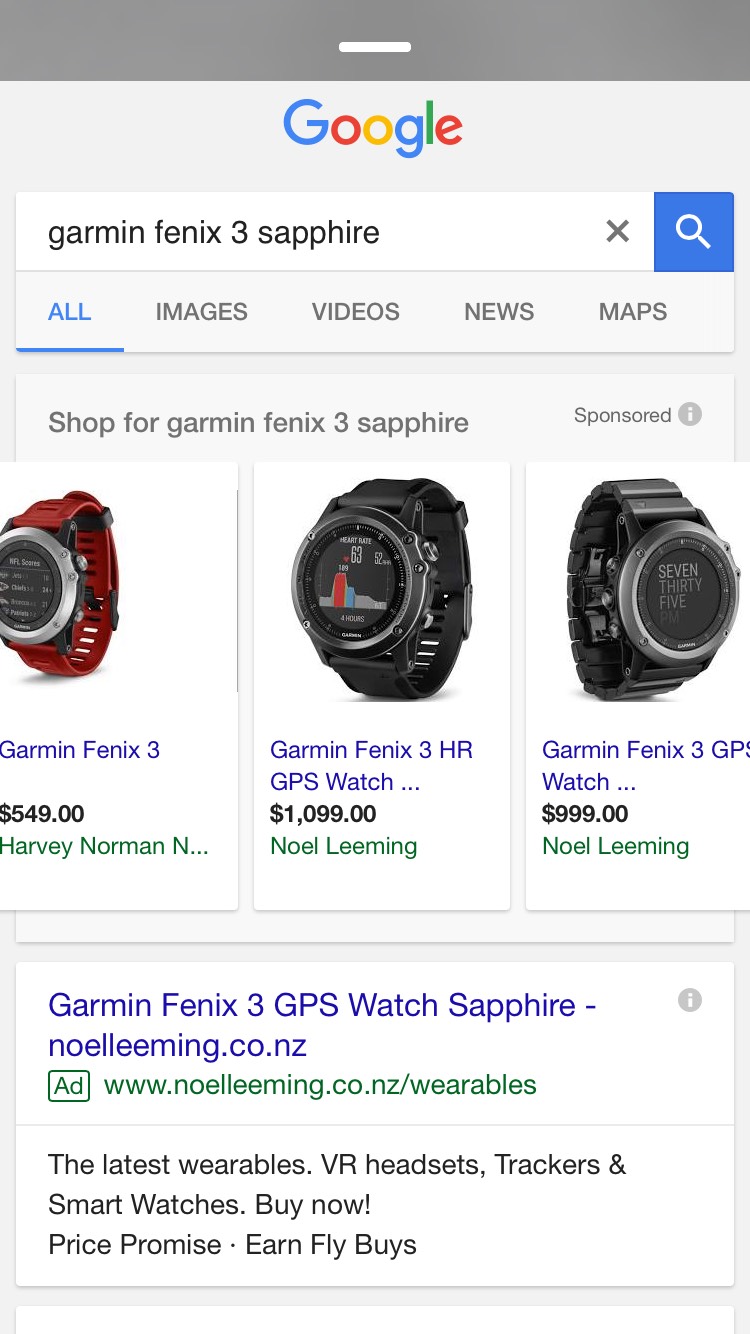Google has finally allowed New Zealand to join the 22 other countries that can now use its Product Listing Ads within the Google Shopping environment, in search. So is this good, great or terrible news for Kiwi companies?
Before I share my prediction, let’s outline what all the fuss is about. You may have noticed new product image ads beginning to infiltrate your search results over the last few weeks. Here’s a snap below from the desktop Google search when looking for a very cool running watch — the Garmin Fenix 3 Sapphire. The images and related details running across the top are the new bits.

This is what the same search result looks like on mobile. In this option you can scroll to the right and see the full list of suppliers who stock this model. It’s a long list

So how does the mechanics of this work? First off, retailers need to establish a Google Merchant Account. This allows them to link their product data with the search advertising platform so that the right images show for the right products with the right prices. Yes, if you have thousands of products this is not going to be a static spreadsheet but a dynamic feed between your e-commerce engine and Google. That way you can ensure you are not advertising something that is out of stock or no longer part of your catalogue.
Fortunately, because Google has taken sooooo long to enable this solution for New Zealand advertisers, you should find a way to hook any reputable e-commerce platform up with a feed that will work with Google. Then once you have the feed sorted you can build your campaign and follow the usual targeting options that are available for any other normal search campaign. This leaves the money side for you to set a budget, bid price and then check the most important part of the process before you hit “go” — the strength of your website analytics.
Ideally, this will be good enough to enable you to differentiate sales from this type of traffic from all the rest you receive. That way you can see if this type of advertising is better than your text-based advertising, as some suggest.
So what’s our take on Google Shopping?
Two points to ponder.
First up, I wouldn’t be surprised if organic search traffic takes a hit as a result of this. These product listing images really stand out when compared with the text-based organic results below. All that hard work to finally crawl the way to the top, and “baboom”, Google now puts a long strip of product images above it all to entice those clickers away.
On the mobile version it gets even worse, with the image ads having a paid text ad below that — pushing those organic rankings even further down the page. I would pay particular attention to organic traffic rolling into a high-ranking product website as this change rolls out.
Second, it’s great if you lead with price — otherwise it’s a disaster. Now at a glance the consumer can see a strip of suppliers offering exactly the same product for what may well be very different pricing. In my example screenshot of the desktop result you see six products from three different retailers and each product shows different pricing. Only one of those retailers I know of and have purchased from before. They just happen to show the most expensive price of the three. If you were shopping for a bargain and didn’t care who got your money, then things all of a sudden became a bit harder for Noel Leeming.
But that said, this could be a very profitable form of advertising for the right product presented to the right audience. Contact us today to learn more. We are actively rolling out Google Shopping campaigns now this option has finally arrived in NZ.
